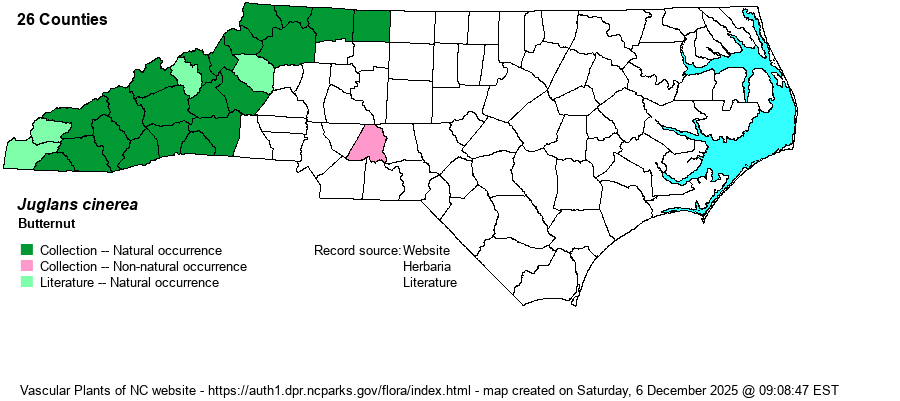| Author | L. | |
| Distribution | Throughout the Mountains, and sparingly in the Piedmont foothills. Records much farther eastward into the central and eastern Piedmont may well be of escaped individuals.
A primarily Northern species, occurring from southeastern Canada to northern GA and AR. It is very scarce in the Piedmont province south of central VA.
| |
| Abundance | Formerly fairly common to possibly common, but owing to the butternut canker disease (fungus), it is now uncommon and strongly declining over the past several decades. Very rare to rare in the Piedmont foothills. It is an NC Watch List species. In the past few years, NatureServe moved the Global Rank from G4 to a more alarming G3. | |
| Habitat | This is a species of rich soil, and thus is found mainly along forested streamsides or floodplains, as well as cove forests, such as the Rich Cove Forest natural community. Where found in more mesic forests, it is primarily over circumneutral soil. |
| Phenology | Blooms in April and May, and fruits in October. | |
| Identification | This is a medium-sized deciduous tree, growing to about 70-80 feet tall on average. The bark is gray with deep furrows. In fall, the elliptical (pecan-like) fruits/husks are visible on the tree or on the ground, and these easily identify the species, as Pecan (Carya illinoensis) is not found as a native species in NC. In leaf, the alternate leaves contain 11-17 pinnate leaflets, each rather elliptical in shape, with the terminal leaflet smaller than most others (unlike with hickories). Black Walnut (J. nigra) has somewhat similar leaves, but it has 15-23 leaflets (normally more than on Butternut), its bark is brownish-black when somewhat mature (about as black as any tree species in our area), and it has the familiar round “baseball” fruit. Owing to the sizable loss of trees to this disease, many biologists are likely not familiar with the species, unless they spend much time along mountain floodplains and cove forests. | |
| Taxonomic Comments | None
| |
| Other Common Name(s) | White Walnut (as opposed to Black Walnut for the other Juglans in our area) | |
| State Rank | S2S3 | |
| Global Rank | G3 | |
| State Status | W5 | |
| US Status | | |
| USACE-agcp | FACU link |
| USACE-emp | FACU link |

